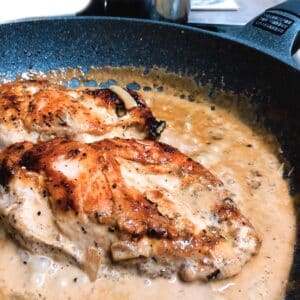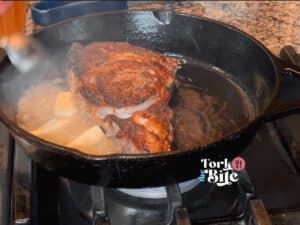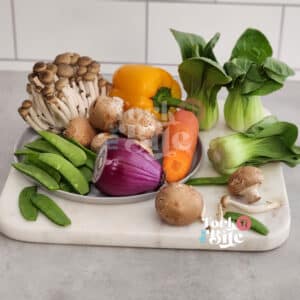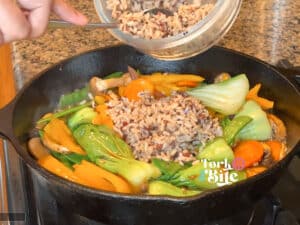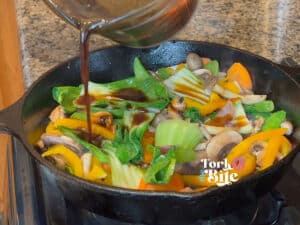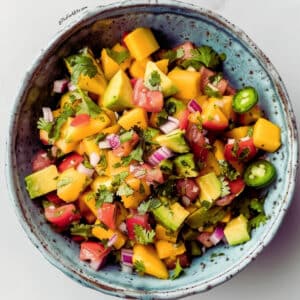The Yard House Steak Bowl is a scrumptious and highly-popular dish served at Yard House, a renowned restaurant chain known for its vast food and drink offerings. This dish has garnered a dedicated fan base for its delightful blend of tender, expertly cooked steak, an array of fresh vegetables, and a savory stir-fry sauce; all served atop a nutritious bed of red rice and quinoa.
Take Aways
- Balance and customize flavors: Ensure that your stir-fry sauce has a harmonious balance of salty, sweet, sour, and umami flavors.
- Cook components separately: To ensure even cooking and maintain the texture of each ingredient, cook the steak, rice, and vegetables separately before combining them.
- Presentation and garnishing: Plate your steak bowl attractively by layering the rice and quinoa blend, vegetables, and sliced steak. Finish with a drizzle of stir-fry sauce and garnish with green onions and sesame seeds for added visual appeal and flavor.
Jump to:

Watch the video: Yard House steak bowl recipe
Ingredients you’ll need:
To create a delicious Yard House Steak Bowl copycat recipe at home, gather the following ingredients:
Steak:
- Choose a high-quality cut, such as ribeye or sirloin.
Base:
Vegetables:
- Bok choy
- Carrots
- Snap peas
- Shiitake mushrooms
- Shimeji mushrooms
- Bell pepper
- Red onion
- Garlic (minced)
Garnish:
- Green onions
- Sesame seeds
Stir-Fry sauce ingredients:
- 1 ½ cups chicken stock
- 2 tablespoon Shaoxing rice wine
- 2 tablespoon brown sugar
- 2 teaspoons sesame oil
- ¼ cup light soy sauce (I used Tamari)
- 1 ½ tablespoon dark soy sauce (Kecap Manis)
- 2 tablespoon oyster sauce
- ¼ teaspoon white pepper
- ½ teaspoon minced garlic
- ½ teaspoon minced ginger
These stir-fry sauce ingredients combine to create a rich and flavorful stir-fry sauce that complements the tender steak, fresh vegetables, and red rice-quinoa blend in the Yard House Steak Bowl.
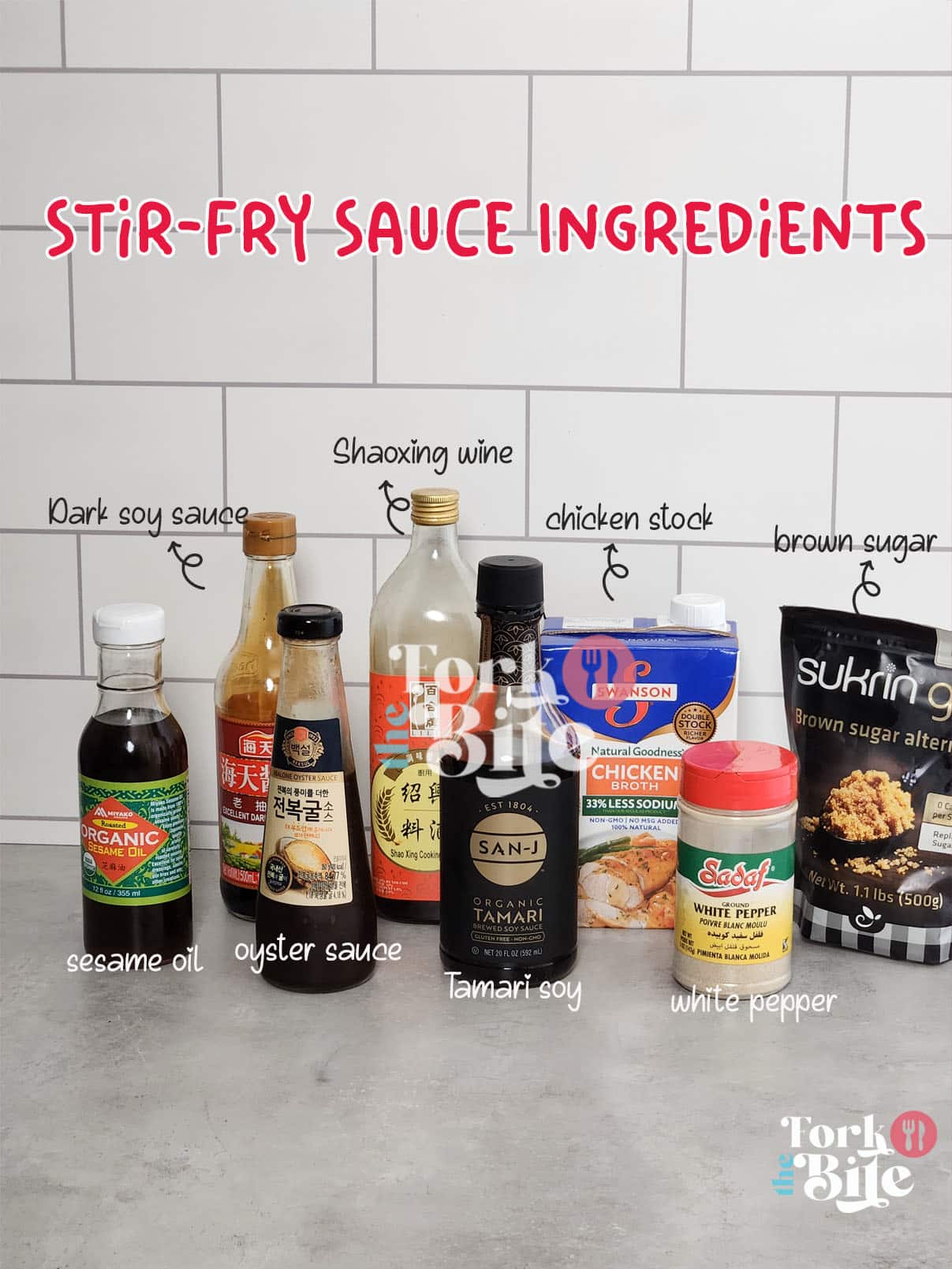
Watch the video
Master the art of cooking a steakhouse-quality steak at home.
Begin by cooking the steak first before proceeding with anything else. I've discovered just how effortless it is to create a mouthwatering dish. I need some top-notch steaks, extra virgin olive oil, salt and pepper, and a bit of butter to whip up a culinary masterpiece.
Follow these step-by-step instructions to create the perfect steakhouse steak at home:
Step 1 Choose the right cut:
Select a high-quality cut of steak, such as ribeye, filet mignon, or strip steak. Look for good marbling (white fat within the muscle), as it enhances the flavor and tenderness of the steak.
Step 2 Bring to room temperature:
Remove the steak from the refrigerator and let it sit at room temperature for 30-60 minutes. This will ensure even cooking throughout the steak.
Step 3 Preheat the oven:
Preheat your oven to 400°F (200°C) in preparation for finishing the steak after searing.
Step 4 Season the steak:
Pat the steak dry using paper towels to remove excess moisture. Generously season both sides of the steak with salt and freshly ground black pepper. You can also add your favorite steak seasoning, garlic powder, or herbs for additional flavor.
Step 5 Heat the pan:
Place a heavy-bottomed, oven-safe skillet (preferably cast iron) over medium-high heat. Allow the pan to get very hot but not smoking.
Step 6 Sear the steak:
Add a small amount of oil with a high smoke point (such as vegetable or grapeseed oil) to the hot pan. Carefully place the steak in the pan and sear for 2-3 minutes per side or until a beautiful brown crust forms.
Step 7 Add butter and aromatics (optional):
Reduce the heat to medium. Add a few tablespoons of unsalted butter, crushed garlic cloves, and sprigs of fresh herbs (such as thyme or rosemary) to the pan. Tilt the pan slightly and continuously spoon the melted butter over the steak for about 1 minute to enhance the flavor.
Step 8 Finish in the oven:
Transfer the skillet with the steak to the preheated oven. Cook for 5-7 minutes for medium-rare or until the steak reaches your desired level of doneness. Use a meat thermometer to check the internal temperature – it should read 130-135°F (54°-57°C) for medium-rare.
Step 9 Rest the steak:
Remove the steak from the oven and transfer it to a cutting board or plate. Tent it loosely with aluminum foil and let it rest for about 5-10 minutes. This allows the juices to redistribute within the steak, ensuring a moist and tender result.
Step 10 Slice and serve:
After resting, slice the steak against the grain (if necessary) and serve it with your favorite side dishes. Enjoy your perfectly cooked steakhouse steak at home!
Read:
Step-by-step instructions to make the dish:
Step 1 Prepare the steak:
Cook the steak according to the instructions for the perfect steakhouse steak. Once cooked, let it rest and slice it into strips.

Step 2 Prep the stir-fry sauce:
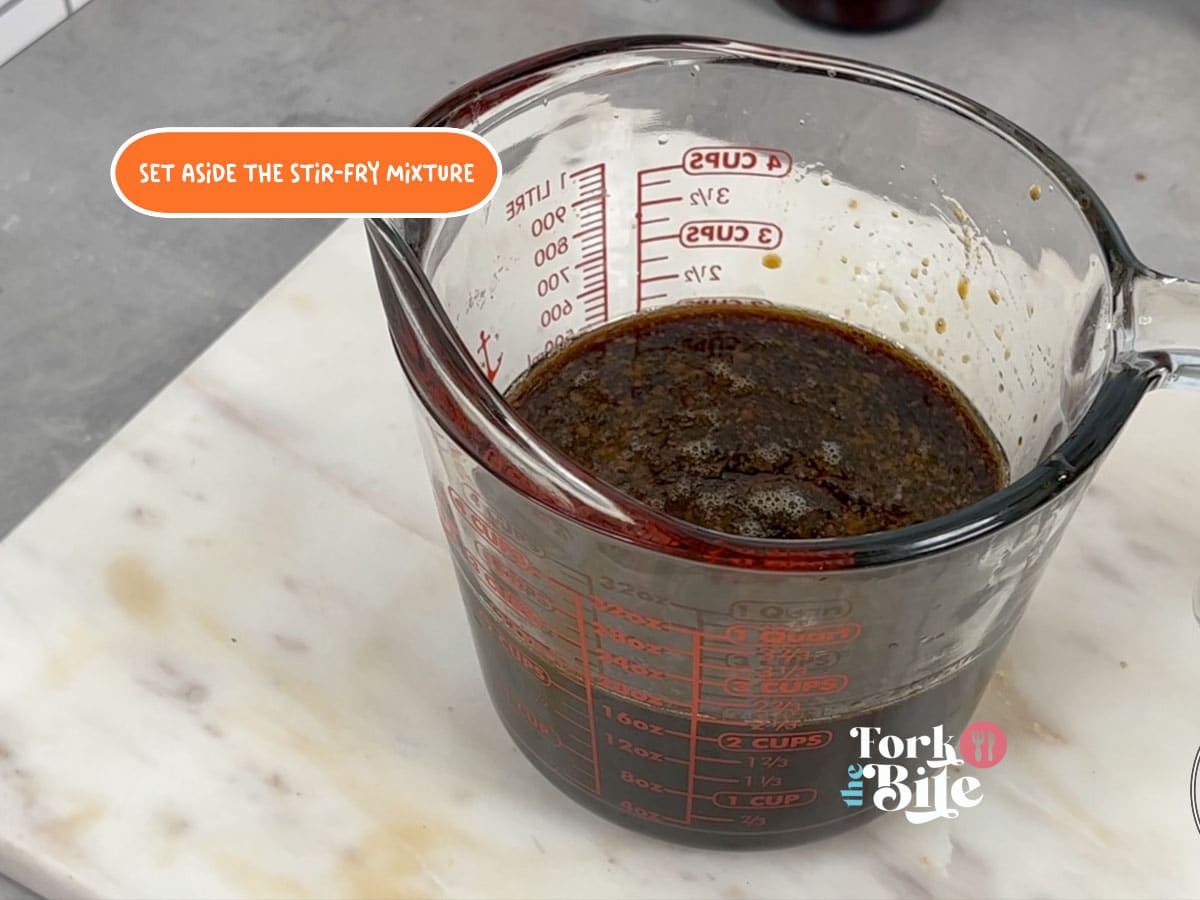
- Combine liquids: In a medium-sized bowl or measuring cup, pour in the chicken or vegetable stock, Shaoxing wine, sesame oil, soy sauce, dark soy sauce, and oyster sauce. Mix well to combine.
- Add sugar and seasonings: To the liquid mixture, add brown sugar, white pepper, minced garlic, and minced ginger. Stir thoroughly to ensure that the sugar dissolves and the flavors meld together.
- Taste and adjust: Sample the sauce and adjust the seasoning as needed. Depending on your taste preferences, you may want to add more sugar, soy sauce, or oyster sauce.
- Optional thickening: If you prefer a thicker sauce, create a cornstarch slurry by mixing cornstarch and cold water in equal parts. Stir the slurry into the sauce until well combined.
- Set aside: Keep the prepared stir-fry sauce nearby as you cook the other components of your Yard House Steak Bowl.
Step 2 Cook the brown rice with Quinoa:
Follow the package instructions to cook the brown rice and quinoa mix. Set aside and keep warm.

Step 3 Prepare the vegetables:
Wash and chop the bok choy, carrots, snap peas, shiitake mushrooms, shimeji mushrooms, bell pepper, and red onion. Mince the garlic and set aside.
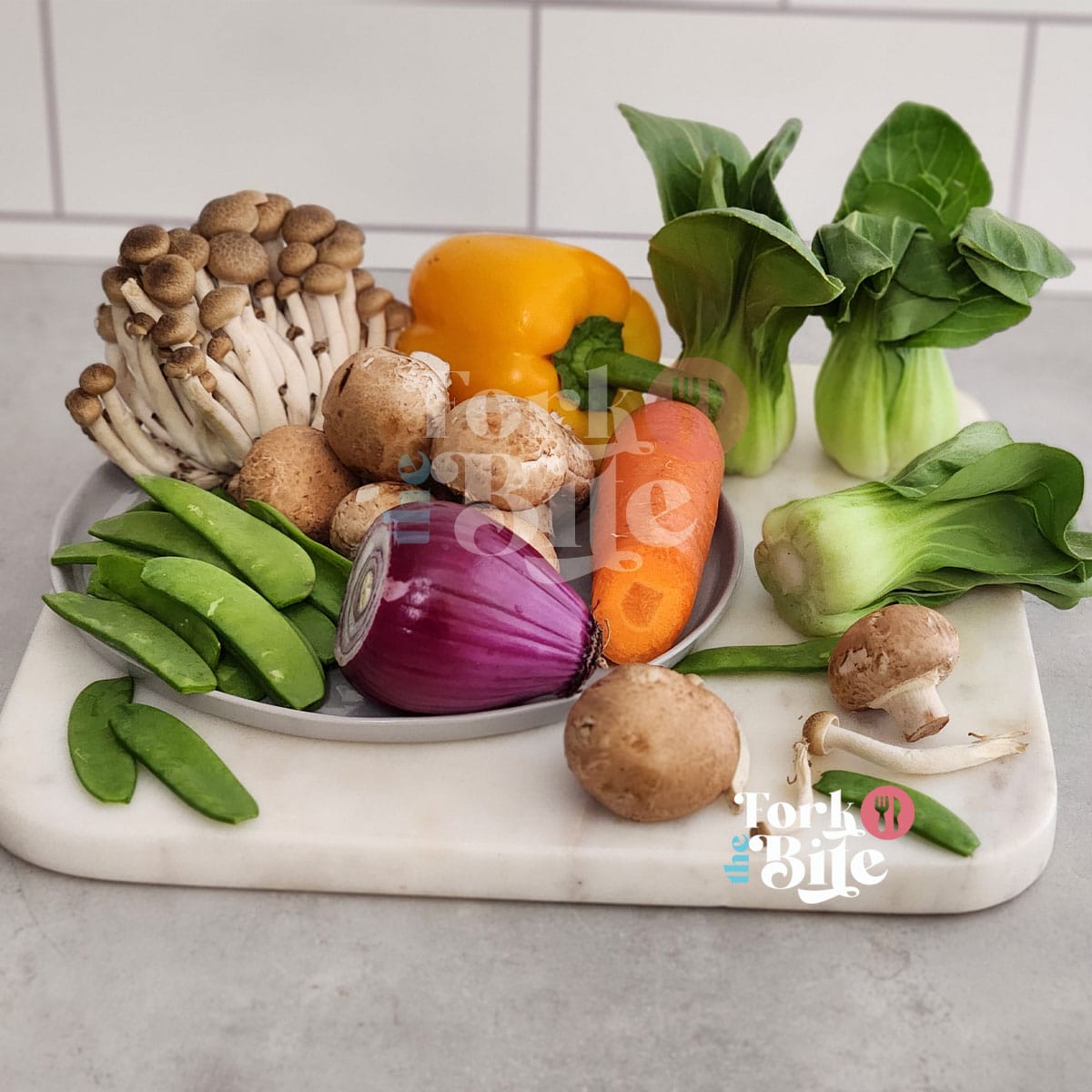
Step 4 Stir-fry the vegetables:
Heat 1-2 tablespoons of oil over medium-high heat in a large skillet or wok. Add the minced garlic and red onions, and cook until fragrant, about 30 seconds.

Step 5 Add the vegetables:
Add the baby bok choy, carrots, snap peas, shiitake mushrooms, shimeji mushrooms, and bell pepper to the pan. Stir-fry the vegetables for 30 seconds or until they are tender-crisp. Add the red rice + Quinoa.
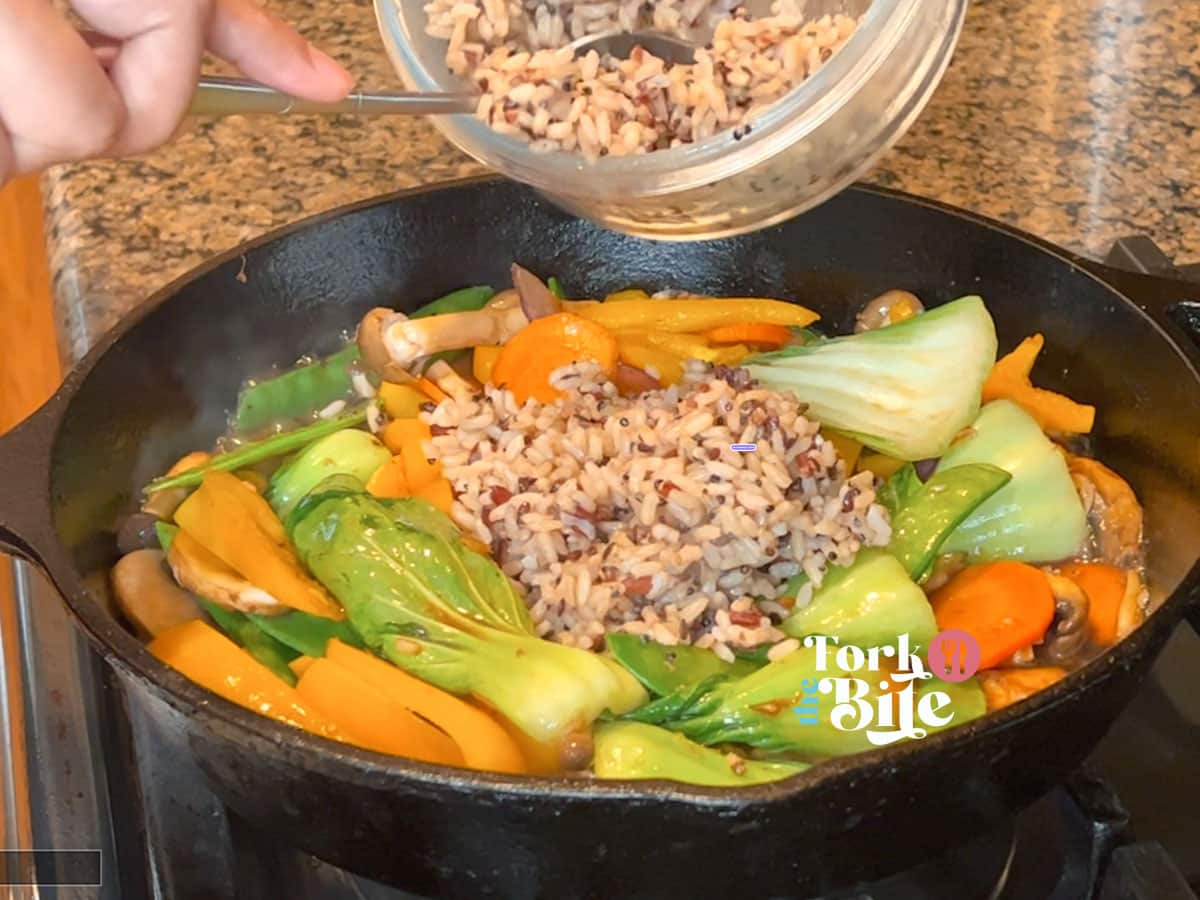
Step 6 Add the stir-fry sauce:
Pour 2 to 3 tablespoon of the prepared stir-fry sauce into the skillet with the vegetables, stirring to coat them evenly. Let the sauce simmer for 1-2 minutes to thicken slightly and allow the flavors to meld.

Step 7 Add the steak:
Elevate your steak bowl by placing perfectly cooked, tender, and juicy slices of steak on top, showcasing the star ingredient of this delicious dish.

Step 8 Assemble the bowls:
Divide the cooked brown rice and quinoa mixture between serving bowls. Top with the stir-fried steak and vegetables, distributing them evenly.
Step 9 Garnish and serve:
Sprinkle each bowl with chopped green onions and sesame seeds for added flavor and texture. Serve immediately and enjoy your homemade Yard House Steak Bowl!
Variations and customization options
Feel free to experiment with these variations and customization options to create a Yard House Steak Bowl perfect for your taste buds and dietary needs.
Here are some variations and customization options to consider:
- Protein: Instead of steak, you can use chicken, shrimp, tofu, or tempeh as alternative protein sources. You can adjust the cooking time and technique based on your chosen protein.
- Vegetables: Feel free to swap in or add other vegetables, such as broccoli, zucchini, asparagus, kale, or spinach. You can also mix your favorite vegetables to create a unique combination.
- Rice or grain substitutes: Instead of using brown rice and quinoa, you can try other grains like white rice, jasmine rice, basmati rice, farro, barley, or even cauliflower rice for a low-carb option.
- Gluten-free and vegetarian options: For a gluten-free version, use gluten-free soy sauce or tamari and a gluten-free oyster sauce substitute. For a vegetarian or vegan dish, replace the steak with tofu or tempeh, and use vegetable or mushroom stock in the sauce. You can also use a vegan oyster sauce or a vegetarian stir-fry sauce as an alternative.
- Spice level: Adjust the spice level by adding crushed red pepper flakes, sliced fresh chili peppers, or a dash of hot sauce to the stir-fry sauce.
- Additional flavors: Enhance the flavor profile by adding ingredients like chopped cilantro, crushed peanuts, or a squeeze of fresh lime juice.
- Noodle option: You can replace the rice and quinoa mixture with cooked noodles, such as Udon, soba, or rice noodles, for a different take on the dish.
Read:
Tips and tricks for making the perfect Yard House steak bowl.
- Use quality ingredients: Opt for high-quality steak, fresh vegetables, and good-quality sauces to ensure the best possible flavors in your dish.
- Properly season the steak: Sprinkle salt and pepper generously on the meat before cooking to enhance its flavor.
- Preheat the pan: To achieve a perfect sear on the steak and vegetables, ensure the pan is preheated and hot before adding the ingredients.
- Use a heavy-bottomed skillet or wok: A heavy-bottomed skillet or wok helps to distribute heat evenly, ensuring well-cooked ingredients and a better stir-fry.
- Don't overcrowd the pan: Cook the steak and vegetables in batches if necessary to avoid overcrowding the pan. This will help to achieve a nice sear and maintain the desired texture of the ingredients.
- Control the heat: Adjust the heat as necessary to prevent burning or overcooking the ingredients. Stir-frying typically requires high heat, but you may need to lower the heat when adding the sauce or more delicate ingredients like garlic.
- Slice vegetables uniformly: To ensure even cooking, slice all vegetables into similar sizes.
- Taste and adjust the seasoning: Before serving, taste the dish and adjust the seasoning as needed. You can add extra salt, pepper, or other herbs/spices to suit your preferences.
- Let the steak rest: Allow the cooked steak to rest before slicing and adding it to the dish. This will help to retain its juiciness and tenderness.
- Use a sharp knife: A sharp knife is essential for slicing the steak cleanly and easily. This will help to maintain the presentation and texture of the dish.
Here are some more ideas to enhance your Steak Bowl
Mix and match these suggestions to create a Yard House Steak Bowl that's uniquely yours.
- Toppings: Add some crunch with toasted cashews, almonds, or crispy fried onions. You can also add sliced avocado or a dollop of sour cream for creaminess.
- Sauce variations: Experiment with different sauces like teriyaki, hoisin, or a spicy sriracha-based sauce to change the flavor profile of your dish.
- Marinate the protein: Marinate the steak or other protein options in a blend of soy sauce, garlic, ginger, herbs, and spices of your choice. Allow the protein to marinate for at least 30 minutes or up to a few hours for the best results.
- Pickled vegetables: Add pickled vegetables like cucumber, radish, or carrot for a tangy touch and a burst of acidity that complements the other flavors in the dish.
- Fresh herbs: Garnish your Steak Bowl with chopped cilantro, mint, or basil to add a vibrant, fresh element.
- Drizzle of sauce: Finish the dish with a drizzle of your favorite sauce, like spicy mayo, sriracha, or eel sauce, for an extra layer of flavor.
- Fried egg: Top your Steak Bowl with a fried or sunny-side-up egg for added richness and a creamy yolk to be mixed into the dish.
How to present and plate the Steak Bowl
Presenting and plating the Yard House Steak Bowl copycat recipe beautifully can elevate your dining experience. Follow these tips for an impressive presentation:
- Choose the right bowl: Select a wide, shallow bowl that allows you to showcase the ingredients and gives you enough space to arrange them. A bowl with contrasting ingredients and colors can also enhance the visual appeal.
- Layer the base: Place the cooked brown rice and quinoa mixture at the bottom of the bowl, spreading it evenly to create a stable base for the other ingredients.
- Arrange the ingredients: Neatly arrange the steak slices and vegetables on top of the rice and quinoa mixture. You can group the vegetables by type or mix them for a more colorful presentation. Placing the seared steak prominently in the bowl will highlight its beauty.
- Add height: Create height and visual interest by stacking or piling the ingredients or placing taller ingredients, like bok choy leaves or snap peas, vertically in the bowl.
- Garnish: Sprinkle the chopped green onions and sesame seeds over the top of the dish. You can also add a few sprigs of fresh herbs or a drizzle of sauce for extra flair.
- Color contrast: Use ingredients with contrasting colors to make the dish more visually appealing. For example, use red/yellow bell pepper, green snap peas, or bok choy to create a vibrant presentation.
- Keep it clean: Wipe the edges of the bowl with a clean, damp cloth to remove any stray sauce or ingredients before serving.
- Serve with accompaniments: If desired, serve the Steak Bowl with additional sauce, pickled vegetables, or a small dish of chili flakes on the side to add a personalized touch to the dining experience.
Read:
How to store leftovers?
To store leftovers of the Yard House Steak Bowl properly and maintain their quality, follow these steps:
- Cool the leftovers: Allow the leftovers to cool to room temperature. This helps prevent excess condensation and ensures proper food safety.
- Separate components: To maintain the texture and flavor of each component, store the steak, cooked vegetables, and rice/quinoa mixture separately in airtight containers. This also allows for more customized reheating.
- Refrigerate promptly: Place the cooled leftovers in the refrigerator immediately. Properly stored leftovers should keep for 3-4 days.
- Label and date: To keep track of your leftovers and ensure they are consumed within a safe timeframe, label the containers with the contents and date. This will help you easily identify the leftovers and know when they need to be consumed.
How to reheat leftovers
To properly reheat the leftovers of the Yard House Steak Bowl and maintain their texture and flavor, follow these methods:
1 Skillet Reheating (recommended):
- Separate components: Reheat the steak, cooked vegetables, and rice/quinoa mixture separately to control the texture better and prevent overcooking. Reheating them separately will cook each item evenly without risking over or undercooking.
- Preheat the skillet: Heat a skillet over medium heat and add a small amount of oil or a splash of water to prevent sticking.
- Reheat rice/quinoa: Add the rice/quinoa mixture to the skillet and stir-fry for a few minutes until warmed through. Transfer it to a serving bowl or plate.
- Reheat vegetables: In the same skillet, reheat the vegetables, occasionally stirring, until they are warmed and have regained their desired texture. Add them to the serving bowl or plate.
- Reheat steak: Briefly reheat the slices in the skillet, not overcooking them. Once warmed, add them to the serving bowl or plate. Overcooking can make the steak tough and dry.
2 Microwave Reheating:
- Separate components: To ensure that the texture is just right and prevent overcooking, it's crucial to reheat the steak, cooked vegetables, and rice/quinoa mixture separately. This will prevent them from becoming overcooked and give you better control over the texture.
- Reheat rice/quinoa and vegetables: Place the rice/quinoa mixture and vegetables in a microwave-safe container. Heat for 1-2 minutes, stirring halfway through, until warmed. Transfer them to a serving bowl or plate. Cover with a microwave-safe lid or plate to keep the moisture while reheating.
- Reheat steak: Place the steak slices in a microwave-safe container and cover. Heat for 30-45 seconds, depending on the thickness of the slices, to prevent overcooking.
Note: If the leftovers lack moisture in either of the two methods, add some water or stir-fry sauce while reheating them to regain the required amount of moisture. This will help to restore their original taste and texture.
How to properly freeze the leftovers?
Freezing the leftovers of the Yard House Steak Bowl can help extend their shelf life, but remember that the texture of some components, especially the vegetables, may change after freezing and thawing. To properly freeze the leftovers, follow these steps:
- Cool leftovers: Allow the leftovers to cool to room temperature before freezing to prevent excess condensation and ensure proper food safety.
- Separate components: To maintain the texture and flavor of each component, store the steak, cooked vegetables, and rice/quinoa mixture separately.
- Use freezer-safe containers: Place each component in a freezer-safe container or resealable freezer bag. Remove as much air as possible and seal the containers or bags tightly. Using portion-sized containers can make defrosting and reheating only what you need easier.
- Label and date: Clearly label the containers or bags with the contents and the date to help you keep track of your leftovers and ensure they are consumed within a safe timeframe. Properly stored leftovers can last up to 2-3 months in the freezer.
- Freeze promptly: Place the containers or bags in the freezer as soon as they have cooled to maintain the best quality and freshness.
To reheat the frozen leftovers
- Thaw: Transfer the frozen containers or bags from the freezer to the refrigerator and allow them to thaw slowly, preferably overnight.
- Reheat: Follow the skillet or microwave reheating methods mentioned in the previous answer once thawed. Add a splash of water or extra stir-fry sauce if the leftovers seem dry during reheating.
Pro tips and tricks for cooking the steak, rice, and toppings.
When I'm striving for restaurant-quality results as I whip up a Yard House Steak Bowl at home, I rely on these insider tips and tricks for cooking the steak, rice, and toppings to perfection:
1 Steak:
- Bring the steak to room temperature: Remove the steak from the refrigerator about 30 minutes before cooking. This allows the meat to cook more evenly and achieve a better sear.
- Pat the steak dry: Use a paper towel to pat the steak dry before seasoning and cooking. Removing excess moisture helps create a better sear and crust.
- Season generously: Season the steak liberally with salt and pepper to enhance its flavor. Add garlic powder, onion powder, or a steak seasoning blend for an extra touch.
- Preheat the pan: Ensure your pan, grill, or griddle is preheated before adding the steak. A hot surface will help create a nice sear and keep the steak tender.
- Use a meat thermometer: To ensure the steak is cooked to your desired level of doneness, use a meat thermometer. Insert the probe into the thickest part of the steak without touching the bone or fat to get an accurate reading.
2 Rice:
- Rinse the rice: Rinsing the rice in cold water helps remove excess starch, which can make the cooked rice sticky and clumpy.
- Use the right rice-to-water ratio: From personal experience, I've found that the standard 2-to-1 ratio printed on the package often results in mushy rice. I prefer using 1 ¼ cups of water for perfectly cooked long-grain brown rice for every cup. However, I opt for 1 ½ cups of water per cup of rice for short-grain varieties. I've discovered that the ideal balance for achieving a light, fluffy Quinoa is using 1 ¾ cups of water per cup of Quinoa. If I add more water, the Quinoa tends to become mushy, whereas using less water results in a dish that's too dry.
- Toast the grains: Before cooking, toast the rice and Quinoa in a dry or lightly oiled pan for a few minutes to enhance their nutty flavors.
- Cook the rice and Quinoa together: Cooking the rice and Quinoa together saves time and ensures they absorb the flavors of each other.
3 Toppings:
- Prepare the vegetables: Cut the vegetables into uniform sizes to ensure even cooking.
- Cook the vegetables in batches: Cook each type of vegetable separately, starting with the firmer vegetables like carrots and bell peppers, followed by the more delicate ones like bok choy and snap peas. This ensures that each vegetable is cooked to the right level of tenderness.
- Season lightly: Season the vegetables with a pinch of salt and pepper to enhance their natural flavors without overpowering the dish.
- Use high heat: Cook the vegetables over high heat to achieve a nice sear and keep them crisp-tender.
Tips for making the stir-fry sauce.
To make a delicious and well-balanced stir-fry sauce, consider these tips:
- Balance flavors: Aim for a balance of salty, sweet, sour, and umami flavors. This can be achieved using soy sauce, oyster sauce, sugar or honey, and a splash of vinegar or citrus juice.
- Enhance aromatics: Incorporate fresh garlic, ginger, and green onions to add depth and aroma to your stir-fry sauce.
- Add heat: If you enjoy some spice, consider adding chili paste, chili flakes, or a dash of hot sauce to your stir-fry sauce.
- Customize: Feel free to experiment with additional ingredients like hoisin sauce, sesame oil, fish sauce, or black bean sauce to create a unique flavor profile tailored to your preferences.
- Thicken the sauce: Mix a cornstarch slurry (equal parts cornstarch and cold water) into your sauce to achieve a thicker, more velvety sauce. The sauce will thicken as it cooks and coats the ingredients in your stir-fry.
- Taste and adjust: Before using the sauce in your stir-fry, taste it and adjust the seasoning as needed. You may need more salt, sugar, or acidity to balance the flavors.
- Prepare ahead of time: Mix the sauce ingredients in a small bowl or jar before starting your stir-fry. Having the sauce ready will help ensure a quick and seamless cooking process.
FAQs related to this dish:
What type of steak should I use for the Yard House Steak Bowl?
High-quality cuts such as ribeye, sirloin, or New York strip work well for this dish. Choose a steak with good marbling for the best flavor and tenderness.
Can I make a vegetarian or vegan version of the Yard House Steak Bowl?
Substitute the steak with tofu, tempeh, or your favorite plant-based protein. Use a vegetarian or vegan oyster sauce alternative in the stir-fry sauce.
Can I use white rice instead of brown rice and Quinoa?
White rice can be used as a substitute for brown rice and Quinoa. Adjust the cooking time and water-to-rice ratio according to the package instructions.
Can I use frozen vegetables in the Yard House Steak Bowl?
Yes, you can use frozen vegetables. However, the texture may be slightly different compared to fresh vegetables. Thaw and drain any excess moisture before adding them to the stir-fry.
Is making a low-sodium version of the Yard House Steak Bowl possible?
Yes, you can reduce the sodium content by using low-sodium soy sauce, low-sodium chicken or vegetable stock, and adjusting the amount of added salt. Be mindful of other ingredients like oyster sauce, which may also contribute to the sodium content.
How can I make the stir-fry sauce gluten-free?
To make the stir-fry sauce gluten-free, use gluten-free soy sauce or Tamari and a gluten-free oyster sauce alternative. Ensure that any other sauce ingredients you add are also gluten-free.
Can I prepare the Yard House Steak Bowl ahead of time for meal prep?
You can cook the dish's components separately and store them in individual containers in the refrigerator. Reheat and combine the components when you're ready to enjoy the meal.
Full Recipe
Yard House Steak Bowl
Pin RecipeIngredients:
Steak:
- 1 lb Ribeye or sirloin (Choose a high-quality cut)
Base:
- 1 cup Brown rice (with Quinoa)
Vegetables:
Stir-Fry Sauce:
- 1½ cup chicken stock
- 2 tablespoon Shaoxing rice wine
- 2 tablespoon brown sugar
- 2 teaspoon sesame oil
- ¼ cup Tamari soy sauce (or light soy sauce)
- 1½ tablespoon dark soy sauce
- 2 tablespoon oyster sauce
- ¼ teaspoon white pepper
- 1 teaspoon garlic (minced)
- 1 teaspoon ginger (minced)
Garnish:
- sesame seeds
- green onions
Watch the Video:
Instructions:
Prepare the steak:
- Cook the steak according to the instructions for the perfect steakhouse steak. Once cooked, let it rest and slice it into strips.
Prep the stir-fry sauce:
- Combine liquids: In a medium-sized bowl or measuring cup, pour in the chicken or vegetable stock, Shaoxing wine, sesame oil, soy sauce, dark soy sauce, and oyster sauce. Mix well to combine.
- Add sugar and seasonings: To the liquid mixture, add brown sugar, white pepper, minced garlic, and minced ginger. Stir thoroughly to ensure that the sugar dissolves and the flavors meld together.
- Taste and adjust: Sample the sauce and adjust the seasoning as needed. Depending on your taste preferences, you may want to add more sugar, soy sauce, or oyster sauce.
- Optional thickening: If you prefer a thicker sauce, create a cornstarch slurry by mixing cornstarch and cold water in equal parts. Stir the slurry into the sauce until well combined.
- Set aside: Keep the prepared stir-fry sauce nearby as you cook the other components of your Yard House Steak Bowl.
Cook the brown rice with quinoa:
- Follow the package instructions to cook the brown rice and quinoa mix. Set aside and keep warm.
Prepare the vegetables:
- Wash and chop the bok choy, carrots, snap peas, shiitake mushrooms, shimeji mushrooms, bell pepper, and red onion. Mince the garlic and set aside.
Stir-fry the vegetables:
- Heat 1-2 tablespoons of oil over medium-high heat in a large skillet or wok. Add the minced garlic and red onions, and cook until fragrant, about 30 seconds.
Add the vegetables:
- Add the baby bok choy, carrots, snap peas, shiitake mushrooms, shimeji mushrooms, and bell pepper to the pan. Stir-fry the vegetables for 30 seconds or until they are tender-crisp. Add the red rice + Quinoa.
Add the stir-fry sauce:
- Pour 2 to 3 tablespoons of the prepared stir-fry sauce into the skillet with the vegetables, stirring to coat them evenly. Let the sauce simmer for 1-2 minutes to thicken slightly and allow the flavors to meld.
Add the steak:
- Elevate your steak bowl by placing perfectly cooked, tender, and juicy slices of steak on top, showcasing the star ingredient of this delicious dish.
Assemble the bowls:
- Divide the cooked brown rice and quinoa mixture between serving bowls. Top with the stir-fried steak and vegetables, distributing them evenly.
Garnish and serve:
- Sprinkle each bowl with chopped green onions and sesame seeds for added flavor and texture. Serve immediately and enjoy your homemade Yard House Steak Bowl!
Notes:
Master the art of cooking a steakhouse-quality steak at home.
Step 1 choose the right cut:
Select a high-quality cut of steak, such as ribeye, filet mignon, or strip steak. Look for good marbling (white fat within the muscle), as it enhances the flavor and tenderness of the steak.Step 2 bring to room temperature:
Remove the steak from the refrigerator and let it sit at room temperature for 30-60 minutes. This will ensure even cooking throughout the steak.Step 3 preheat the oven:
Preheat your oven to 400°F (200°C) in preparation for finishing the steak after searing.Step 4 season the steak:
Pat the steak dry using paper towels to remove excess moisture. Generously season both sides of the steak with salt and freshly ground black pepper. You can also add your favorite steak seasoning, garlic powder, or herbs for additional flavor.Step 5 heat the pan:
Place a heavy-bottomed, oven-safe skillet (preferably cast iron) over medium-high heat. Allow the pan to get very hot but not smoking.Step 6 sear the steak:
Add a small amount of oil with a high smoke point to the hot pan. Carefully place the steak in the pan and sear for 2-3 minutes per side or until a beautiful brown crust forms.Step 7 add butter and aromatics (optional):
Reduce the heat to medium. Add a few tablespoons of unsalted butter, crushed garlic cloves, and sprigs of fresh herbs (such as thyme or rosemary) to the pan. Tilt the pan slightly and continuously spoon the melted butter over the steak for about 1 minute to enhance the flavor.Step 8 finish in the oven:
Transfer the skillet with the steak to the preheated oven. Cook for 5-7 minutes for medium-rare or until the steak reaches your desired level of doneness. Use a meat thermometer to check the internal temperature – it should read 130-135°F (54°-57°C) for medium-rare.Step 9 rest the steak:
Remove the steak from the oven and transfer it to a cutting board or plate. Tent it loosely with aluminum foil and let it rest for about 5-10 minutes. This allows the juices to redistribute within the steak, ensuring a moist and tender result.Step 10 slice and serve:
After resting, slice the steak against the grain (if necessary) and serve it with your favorite side dishes. Enjoy your perfectly cooked steakhouse steak at home!Nutrition Information:
Please note that all nutrition information are just estimates. Values will vary among brands, so we encourage you to calculate these on your own for most accurate results.

